2019 marks Kovach’s 50th Anniversary. Since 1969 we have had the privilege of contributing to some of the countries most amazing projects. While our current solutions include glass, stone, and terracotta, we must never forget that our origins were in metal roofing and wall panel systems. To this day you can walk our metal shop floor and sense the pride and witness the craftsmanship that goes into each and every metal panel that leaves our facilities.
Our heritage and history have earned Kovach a position of expertise in the marketplace, and as such we receive many inquiries about best practices for metal cladding solutions. One topic we seem to address quite frequently is related to a family of materials we call Specialty Metals. Specialty Metals refers to pure metals or alloys that typically are left exposed to the elements (non-painted) and have unique beautifying design characteristics.
The purpose of this article is to address many of the questions we receive about some of the more common Specialty Metals we encounter. Specifically we will address copper, Muntz metal, weathered steel, stainless steel, and zinc.
Copper
Of the five metals discussed in this article, copper is likely the one people are the most familiar with. However, there are some things that may surprise you about this incredibly versatile metal. For example, did you know that researchers estimate we are still using about 80% of all the copper ever mined? Copper has tremendous recyclability, and in many cases outlasts the very building it was meant to serve. Copper has been used by humans for over 10,000 years in everything from pots and jewelry, to computer parts and building materials. It’s longevity, strength, malleability, and aesthetic beauty make it an ideal candidate for exterior cladding.
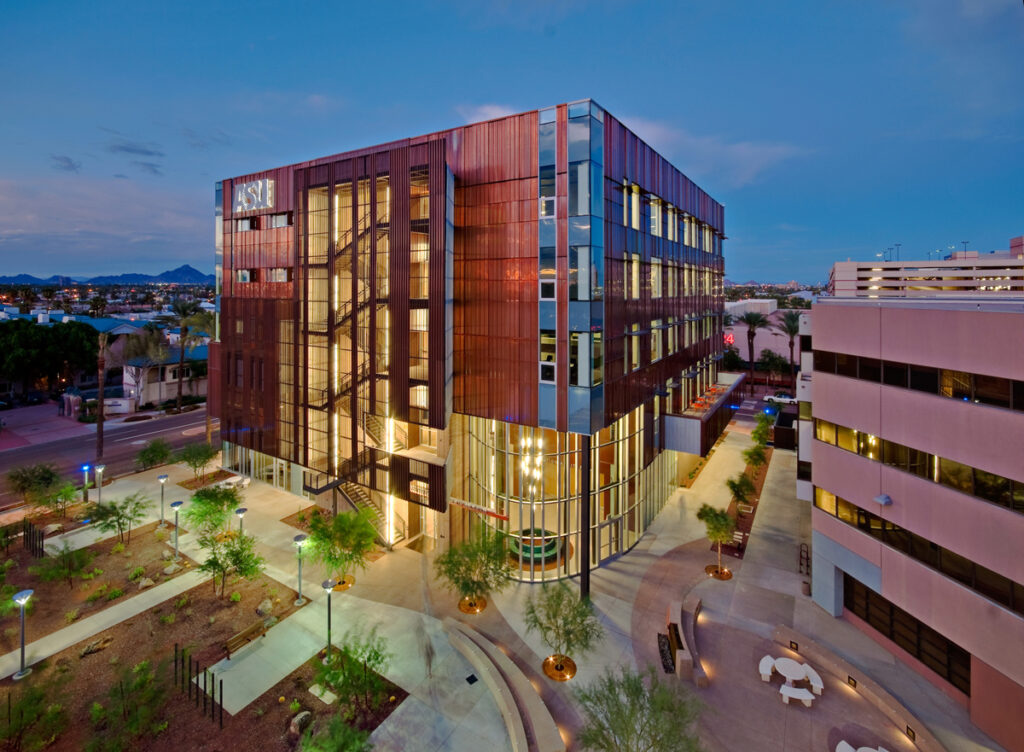
Copper comes in many alloys, however in architectural paneling it is 99.9% pure copper. The 0.1% represents impurities that are virtually impossible to purge and do not affect its performance. Copper thickness is typically expressed in ounces per square foot. For example, a 16 oz copper panel will be about 0.0216” thick. Panel widths are limited by coil sizes, which typically do not exceed 48”, however there are larger customized solutions available. Due to its high level of strength and malleability, copper panels respond very well to custom bends and perforations, making design options virtually endless.
Perhaps the most iconic feature of copper is the rich and timeless variations of color in its evolving stages of patina. As a non-ferrous metal, it contains no iron, and therefore will not rust. Copper manifests a wide array of patinas and colors as it is exposed to oxygen, humidity, and atmospheric carbon dioxide molecules. In ideal conditions, copper will turn a dark brown in the first year followed by tints of green in the next 2-5 years. Depending on location, copper panels will transform to almost a solid green in years 7-15. When patina is fully matured, copper achieves a bluish green color in about 20-30 years. The patina graduation is largely dependent on the unique local weather. The Statue of Liberty is a great example of patina that is completely void of its original reddish brown color due to the humid coastal environment in which it resides. Copper on buildings in arid desert climates get much darker and develop deep earthy tones of brown and orange, but due to the lack of moisture in the air, green and blue hues are never revealed.
If a specific stage of patina is desired, there are shop controlled, pre-weathering processes that can achieve the intended coloration. An optional clear coat can significantly reduce further weathering however it may not eliminate it entirely. In most cases we recommend pre-weathering and clear coating to be done only for interior applications. As with all Speciality Metals, we suggest letting metal panels in exterior applications patina and adjust naturally to the local environment, however we are open to exceptions.
In addition to the natural aesthetics, versatility, and longevity, copper has the added benefit of being virtually maintenance free so long as a natural patina look is desired. In fact, using chemical cleaners and other acidic solvents can temporarily stain panels. In time, the natural weathering of panels will self correct these mistakes, but it may take years for the changes to become noticeable.
Over the years, Kovach has completed copper jobs all across the US. Some of our most notable work has been in copper including the multi-phased Biomedical Campus for The University of Arizona. This project won multiple awards including the 2014 “North American Copper in Architecture Award” and ENRs 2017 “Best of the Best Projects.”
Muntz
As mentioned above, copper has many alloys used in architectural applications. Brass and bronze are common alloys using primarily copper and zinc blended with small amounts of tin, iron, silicon and manganese. Muntz metal belongs to the family of brass alloys and is made of 60% copper and 40% zinc. Of all the brasses, Muntz has the highest zinc ratio which creates a very interesting patina that is quite different from pure copper or even other brasses. It goes by a few different names including Yellow Metal or C280 (C28000). Muntz was originally used in nautical applications as a method of protecting the wooden hulls of a ship in the 1800’s. Over the many years since cladding the underside of boats, its use in architecture has grown in popularity.
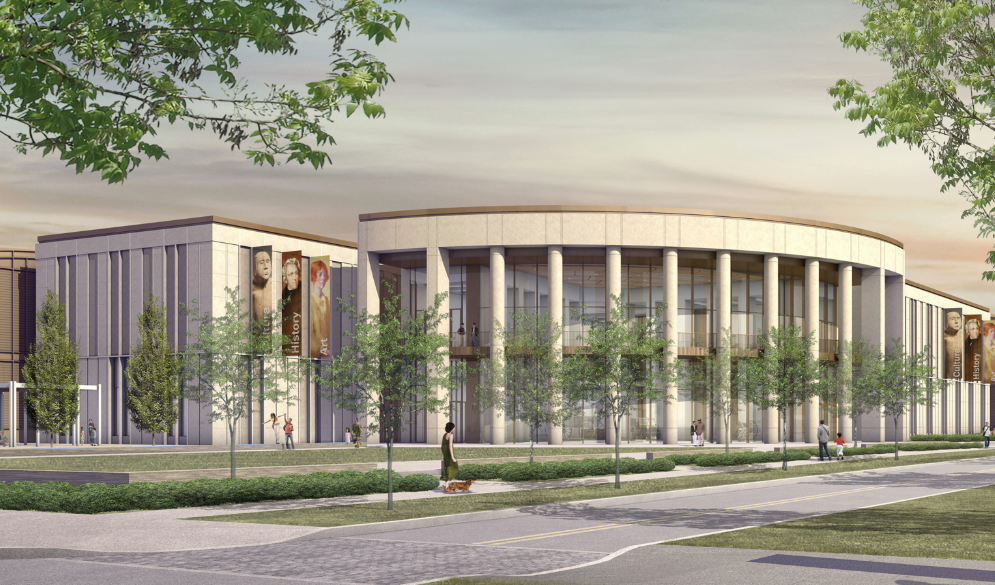
As mentioned above, copper has many alloys used in architectural applications. Brass and bronze are common alloys using primarily copper and zinc blended with small amounts of tin, iron, silicon and manganese. Muntz metal belongs to the family of brass alloys and is made of 60% copper and 40% zinc. Of all the brasses Muntz has the highest zinc ratio which creates a very interesting patina quite different from pure copper or even other brasses. It goes by a few different names including Yellow Metal or C280 (C28000). Muntz was originally used in nautical applications in the 1800s as a method of protecting the wooden hull of ships. Over the many years since cladding the underside of boats its use in architecture has grown in popularity.
As a blend primarily based on copper, Muntz has many of the same qualities in terms of versatility, longevity, and strength. Kovach is currently participating in the construction of one the largest use cases of Muntz exterior cladding in the US – The Tennessee State Museum in Nashville. Since Muntz isn’t quite as common for wall panels, it’s more difficult to find manufacturers that can produce large sheets when compared to copper. Due to our experience with the product, we have a healthy supplier network that can produce various sizes and thicknesses. Muntz thickness is typically expressed in millimeters (mm), unlike copper which is expressed on ounces.
In its raw form, Muntz is bright yellow in color, which changes dramatically if left to patina naturally and under the right conditions. In time it will lose its original shiny brass luster, and turn to a dark blackish red color in about 1-5 years. In 5-10 years the blackness will fade leaving a moderately dark reddish orange coloration. Humidity and atmospheric carbon dioxide molecules play a major role in the extremity of the patina. In many cases designers wish to keep the original bright color which is possible with either clear coating or polishing with regular maintenance.
The allure of Muntz speaks for itself. The brilliance of its glowing brass finish and versatility make it a great consideration for any monumental project that seeks to be more than just a building. Between Tennessee State Museum and smaller scale Muntz projects, Kovach has become a leading expert through fabricating and installing this very unique product.
Weathered Steel
Weathered steel has been used in exterior cladding since the 1960’s, making it the newest Specialty Metal on our list. Weathered steel first started to be used in architectural cladding in the mid 1960’s. Its popularity declined for a number of years while architects and builders were struggling with the best methods to utilize it. However, in recent years weathered steel has made a strong comeback, and we are continually peppered with questions about best practices for usage, appearance, and long-term maintenance.
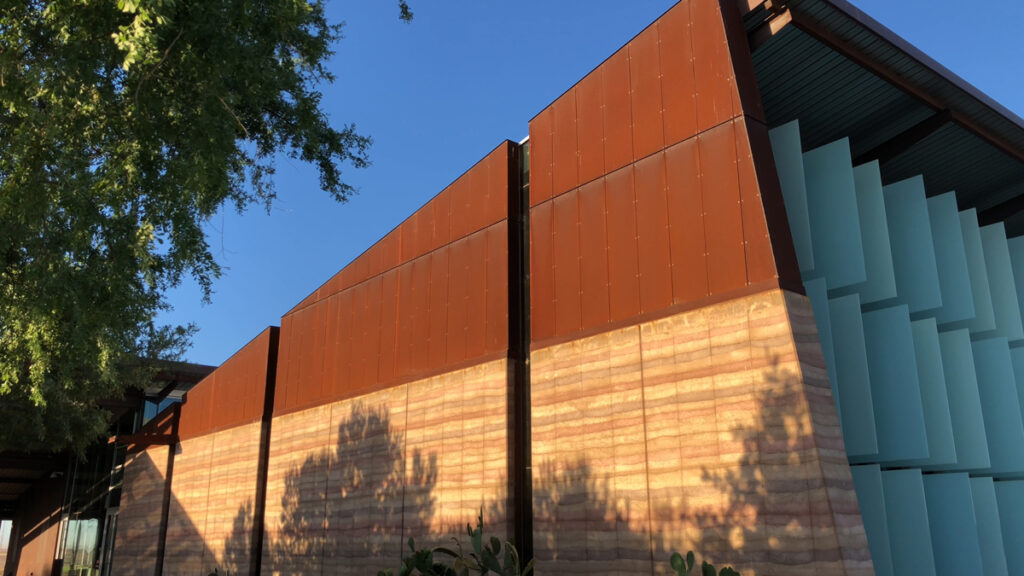
Weathered steel, or COR-TEN by its trademarked name, is a steel alloy containing copper, nickel, and chromium. The technical name for weathered steel alloy is A606. Due to the combined properties of the metals, a corrosive barrier forms on the outside of the panel when exposed to weather conditions. This barrier has functional and aesthetic qualities. If damage does occur to the outer layer, and it flakes off or is removed, another protective layer will form in its place making it virtually maintenance free.
Weathered steel has a very rapid patina process. Almost immediately panels will turn a bright sunburst orange followed by a dark red after about 1-2 years. At about 3-6 years, the steel will darken to a deep earthy brown color and remain in this stage with little variation.
There are some climates where weathered steel is not recommended. Environments that are heavy with salt, fog, and generally wet climates can be a challenge. The metal must have periods where it can dry out, otherwise the corrosive protective layer will never fully form. Any applications where water is continually running, such as gutters, leaders, water features, etc. are not recommended. If you desire the look of weathered steel but project constraints eliminate it as a viable option, you can opt for painted products. Kovach has a great network of vendors that can supply painted products that closely resemble naturally occurring weathered steel.
A concern many designers and owners have with weathered steel is the susceptibility of rust leaching onto adjacent parts of the building. When panels are first installed, they have the highest likelihood to bleed and stain adjacent materials. We agree that this is something to be aware of, but it doesn’t mean that weathered steel needs to be ruled out as a viable option. Over the years we have developed ways to reduce the impact of leaching. If you are concerned about staining, please give us a call and we can talk through ways to manage this on your project.
Panel widths are typically limited to 48”, but there are many custom size options available. Selecting the right size panel is really going to be dictated by attachment system, framing, gauge, and other unique conditions of your project.
Panel thickness is especially important when considering weathered steel. When the product was in its early days, it was discovered that going too thin was problematic. Corrosion layers would build on each side and eat all the way through panel. In time, ASTM standards were released that indicated weathered steel panels should be at least 16 gauge or thicker. We have found that safe panel thickness is determined by many different factors and can be thinner than 16 gauge based on job and climate conditions.
Stainless Steel
If the rustic earthy tone of weathered steel isn’t what you are looking for, than stainless steel may be the right solution for your project. In terms of appearance these two steel alloys could not be more opposite.
New York City provides some of the greatest examples of stainless steel in architecture. The Chrysler Building is one of the oldest and most recognizable pillars of stainless steel used in a roofing panel. Almost 100 years later, the spire still shines as bright as it did in 1930. More recently, One World Trade Center also used stainless steel panels as cladding where the curtain wall corners meet.
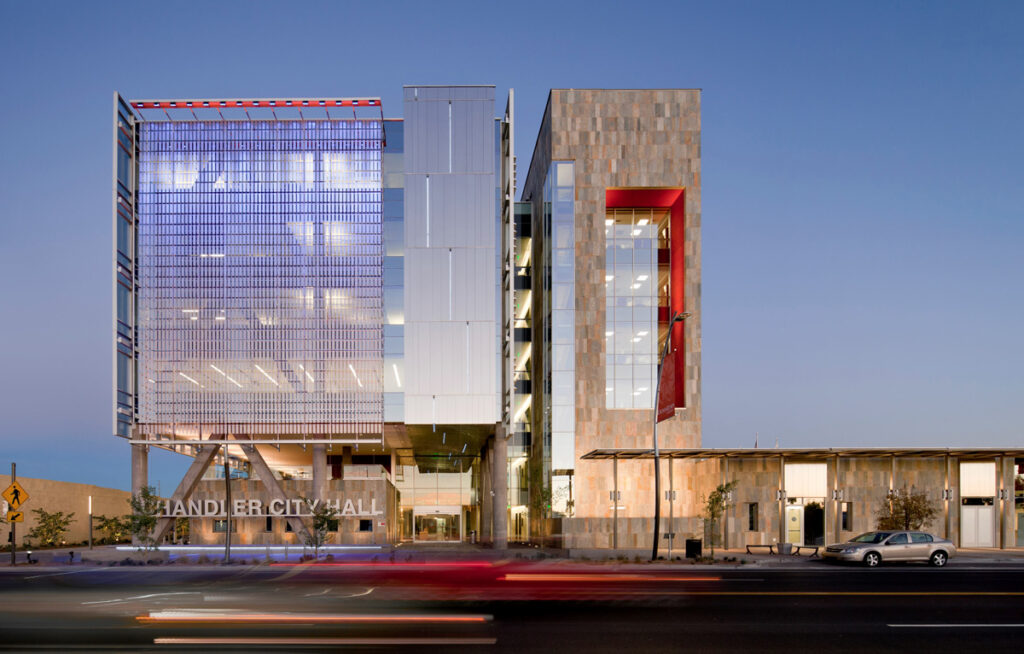
Stainless steel comes in many different alloys, but there are three that are most commonly used in architectural panels – 301, 304, and 316. All three blends include steel, chromium, and nickel, but only 316 contains molybdenum. Molybdenum gives 316 superior protection from corrosion and pitting in high chloride environments. It’s important to keep in mind that stainless steel is not 100% resistant to corrosion, however selecting right alloy and proper maintenance help slow down and reduce deterioration.
It is important that stainless steel roof and wall panels stay clean and dry. Continuously being submerged in water, accumulation of dust and dirt, and exposure to deicing can accelerate corrosion and oxidation. However, there are ways to mitigate corrosion that can can be identified during the design phase of a project. For example, one of the reasons why the roof of the Chrysler Building has remained in such great condition is the regular cleansing of dirt and dust from naturally occurring rainfall. The roof is also designed in such a way that it sheds water efficiently thereby avoiding any pooling or accumulation of water on panels.
Stainless steel is a remarkably versatile product and has been used to adorn some of the most monumental projects across the globe. Manufacturers of architectural stainless steel have developed an abundance of finishes ranging from mirror like luster to rich matte surfaces. Advancements in technology and methods of media blasting have opened the door to a variety of textures and patterns. Coloring of stainless steel can be achieved through electroplating and opaque coatings.
With all the alloys, finishes, and maintenance requirements, stainless steel can be an intimidating product to work with, but with the right team in place, it should not be feared. Kovach has an extensive network of suppliers and a track record of developing creative solutions for some of the most difficult projects.
Zinc
Zinc is another material that has been in use for hundreds of years. In the mid 1800’s it became a common choice for commercial and residential roofing. In the early to mid 1900’s it fell out of usage for cheaper solutions like asphalt shingles. As green building and longevity have become more valued by builders, zinc has become a popular choice once again. Due to its purity and 100% recyclability, zinc is great solution for projects that need to be long lasting and environmentally sustainable.
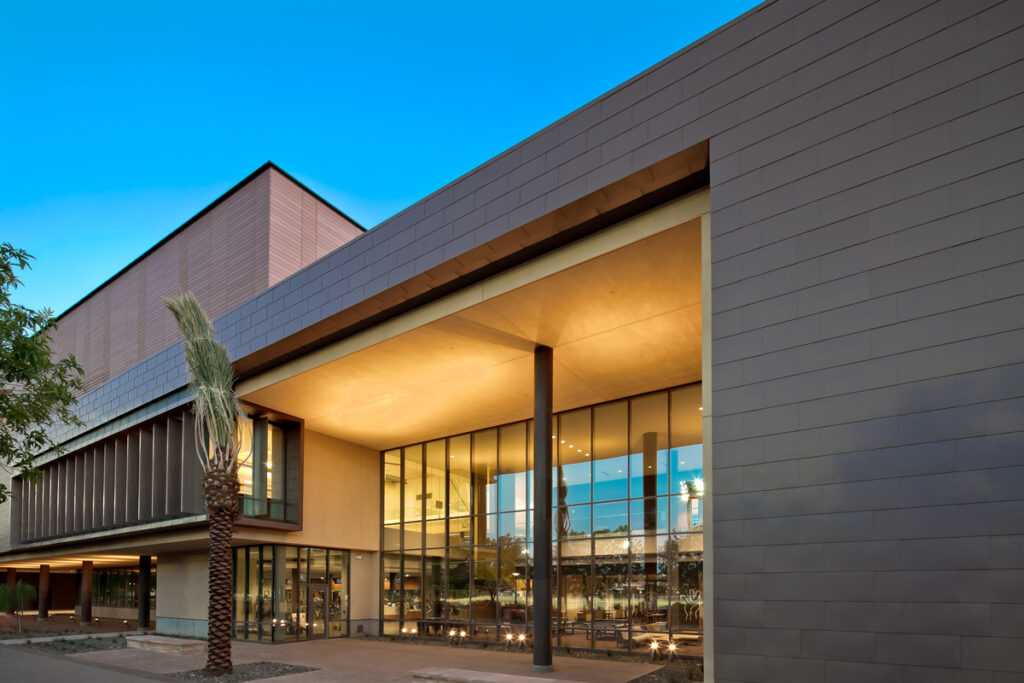
Architectural zinc is 99.995% pure. Small amounts of copper and titanium are added to increase malleability and ductility, which aids in forming shapes and panels. Some of the primary benefits of zinc are its light weight and durability. As with other non-ferrous living metals, zinc forms a protective layer on its exterior that “self heals” when scratched or damaged. Zinc is a very hardy metal and can withstand harsh environments on both extremes of the climate.
Zinc typically comes in three natural shades – light gray, gray, and dark gray. Depending on the manufacturer, there may be some intermediary shades within those three colors. Zinc is a natural product, so as it patinas it will vary in color, however it will always remain in a gray-state, unlike copper which changes colors dramatically.
Zinc panel size is limited by coil and sheet widths which do not exceed 40”. Zinc thickness is typically expressed in millimeters and comes in standard sizes of 0.7mm, 0.8mm, 1.0mm, 1.2mm, and 1.5mm. If the project requires larger or thicker material we can work with our supplier network and likely source the right sized material. In 2013, Kovach completed the Maricopa County Sheriff’s office which called for a unique zinc composite panel. These zinc composite panels combined the best of both worlds by utilizing the natural look of zinc while also benefiting from the uniform flatness of a composite core panel.
Due to its dark color and metallic properties, zinc rapidly absorbs heat and panels can expand and contract quite dramatically. For example, a 30’ long zinc panel can adjust 3/4” when reaching temperatures of 160 degrees. This is important to keep in mind when planning installation systems. If done incorrectly, zinc panels can tear at connection points and panels will need to be replaced. To avoid these problems Kovach can assist in designing a system that allows for safe expansion and contraction, especially in extremely hot environments. Cirrus Logic Headquarters in Austin, Texas, is a great example of the high quality zinc panel work we have performed in the past. This project was completed in 2013 and won the “Metal Construction Association Chairman’s Award.”
You do not need to look far to find examples of zinc standing the test of time. Its superb strength and resilience, coupled with its timeless colorization, make it an ideal choice for projects expected to last over 100 years.
Conclusion
Specialty Metals are just that – special. They require a level of expertise only experience can provide. Over the last 50 years, Kovach has built a reputation for knowing how to work with metals of all types and alloys. If your next project requires something that hasn’t been done before, even better. We thrive on being challenged and pushing ourselves to discover new and exciting ways to use these beautiful, natural products.
If you have an upcoming project that calls for copper, Muntz metal, weathered steel, stainless steel, or zinc, we would be happy to help!

